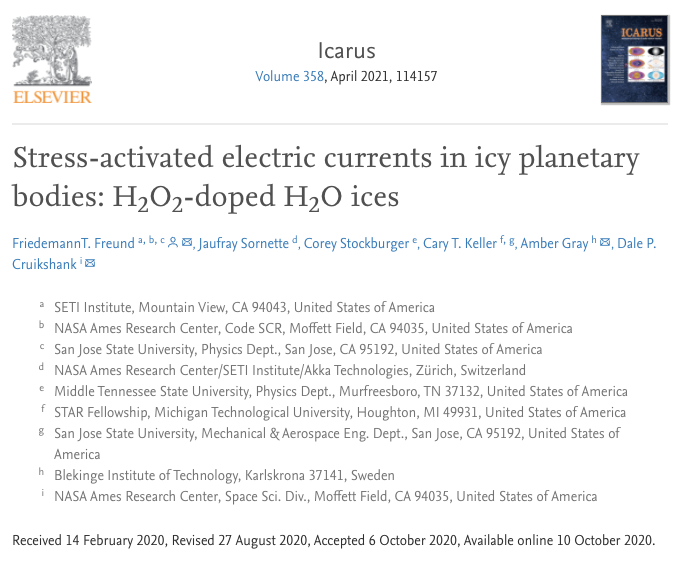
Stress-activated electric currents in icy planetary bodies: H2O2-doped H2O ices
- Post by: Tobias Larsson
- 21st April 2021
- No Comment
Abstract
Planetary satellites such as the Jovian moon Europa and several Kuiper Belt objects (including Pluto) have surfaces consisting largely of H2O ice, which is brittle and behaves as a rock at the low temperatures that prevail in the outer Solar System. Several of those ice-crusted bodies show evidence of tectonic activity indicating high levels of stress. This paper reports on laboratory experiments with pure H2O ice and H2O2–doped H2O ices with H2O2 concentration levels comparable to those in the ices of Europa. Elongated rectangular ice blocks at T = −81 °C [192 K] were stressed at one end to test whether electric currents are generated and capable of flowing down the stress gradient. Pure H2O ice was found to not produce currents above the 10−10 A background level except for occasional transients in the 10−9–10−8 A range during fracture or rapid plastic deformation due to electrons, e’. By contrast, stressing H2O2-doped H2O ices consistently produced electric currents in the 10−7–10−5 A range, due to holes, h•, propagating from the stressed end to the unstressed end. The h• charge carriers are generated by the break-up of peroxy bonds of H2O2 molecules, leading to O−, equivalent to defect electrons or holes h• in the O2− matrix.
Keywords
Water ice, Stress-induced electric currents, Hydrogen peroxide doping, Peroxy defects, Positive hole charge carriers, Electrical conductivity, Stress gradients
Citation
FriedemannT. Freund, Jaufray Sornette, Corey Stockburger, Cary T. Keller, Amber Gray, Dale P. Cruikshank (2021) Stress-activated electric currents in icy planetary bodies: H2O2-doped H2O ices, Icarus, Volume 358, 2021, 114157, ISSN 0019-1035, https://doi.org/10.1016/j.icarus.2020.114157.
